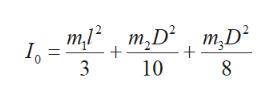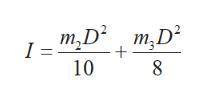
Physics, 20.07.2020 14:01 oreoassassin38
On average, both arms and hands together account for 13% of a person's mass, while the head is 7.0% and the trunk and legs account for 80%. We can model a spinning skater with her arms outstretched as a vertical cylinder (head, trunk, and legs) with two solid uniform rods (arms and hands) extended horizontally. Suppose a 70.0 kg skater is 1.60 m tall, has arms that are each 66.0 cm long (including the hands), and a trunk that can be modeled as being 33.0 cm in diameter. If the skater is initially spinning at 68.0 rpm with her arms outstretched, what will her angular velocity 2 be (in rpm ) after she pulls in her arms and they are at her sides parallel to her trunk? Assume that friction between the skater and the ice is negligble.

Answers: 1


Another question on Physics

Physics, 22.06.2019 02:30
The act of moving from one place to another. a. locomotor b. aerobic c. stationary d. static
Answers: 3

Physics, 22.06.2019 09:00
One form of energy can be another type of energy. a. created to form b. transformed into c. destroyed and then created to form
Answers: 1

Physics, 22.06.2019 16:40
Acapacitor is storing energy of 3 joules with a voltage of 50 volts across its terminals. a second identical capacitor of the same value is storing energy of 1 joule. what is the voltage across the terminals of the second capacitor?
Answers: 3

You know the right answer?
On average, both arms and hands together account for 13% of a person's mass, while the head is 7.0%...
Questions

Mathematics, 30.08.2021 05:00



Mathematics, 30.08.2021 05:00

Chemistry, 30.08.2021 05:00

Mathematics, 30.08.2021 05:00

English, 30.08.2021 05:00



Mathematics, 30.08.2021 05:00

English, 30.08.2021 05:00

English, 30.08.2021 05:10




Mathematics, 30.08.2021 05:10


Mathematics, 30.08.2021 05:10


 ) = 70 kg, }
) = 70 kg, } ) = 1.60 m, }
) = 1.60 m, } ) = 33 cm = 0.33 m, }
) = 33 cm = 0.33 m, } ) = 66 cm = 0.66 m, }
) = 66 cm = 0.66 m, } ) = 13%( 70 ) = 9.1 kg, }
) = 13%( 70 ) = 9.1 kg, } ) = 7%( 70 ) = 4.9 kg, }
) = 7%( 70 ) = 4.9 kg, } ) = 80%( 70 ) = 56, }
) = 80%( 70 ) = 56, }





